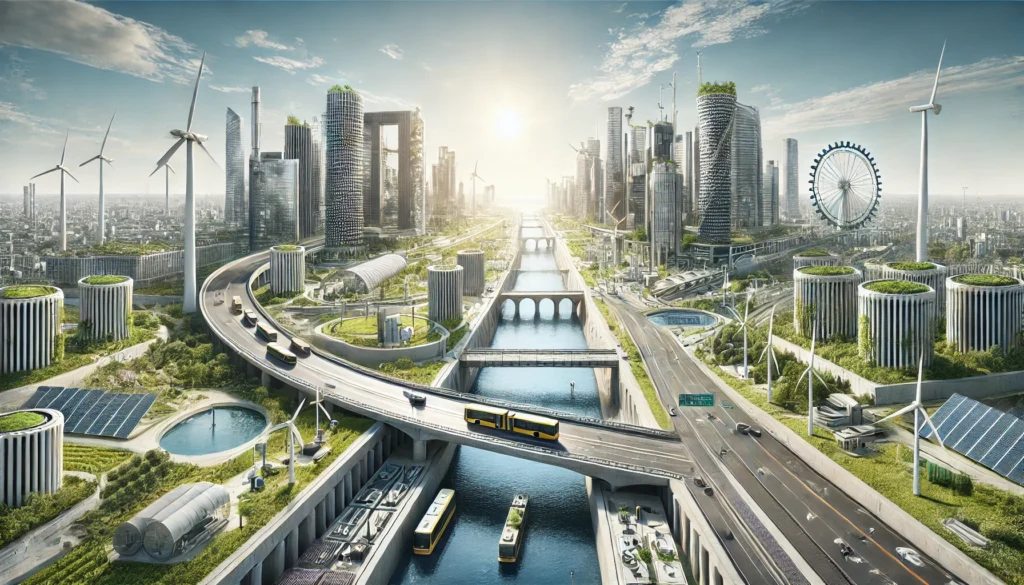Physical Address
304 North Cardinal St.
Dorchester Center, MA 02124
Network
Physical Address
304 North Cardinal St.
Dorchester Center, MA 02124
Network

Climate change is not just an environmental challenge but also a major threat to global infrastructure. Increasing frequency and intensity of extreme weather events necessitates building resilient infrastructure that could endure against these impacts. Thane Ritchie, an investor who has shown commitment to sustainability solutions, underlines how significant building resilience is in ameliorating climate change distortions.
Investing in resilient infrastructure is crucial for safeguarding communities and ensuring long-term sustainability in the face of climate change.
Thane Ritchie
Resilient infrastructure entails measures put in place to enable it absorb, adapt to, and recover from the effects resulting from climate change. This includes structures that can withstand extremes of weather like high sea levels among others so as employment essential services keep going on.
| Element | Description | Examples |
|---|---|---|
| Structural Resilience | Infrastructure that can withstand physical stressors. | Flood-resistant buildings, hurricane-proof homes. |
| Adaptive Capacity | Ability to adjust to changing conditions and recover quickly. | Flexible road designs, adaptive water management systems. |
| Environmental Integration | Incorporating natural systems to enhance resilience. | Green roofs, urban wetlands, coastal mangroves. |
| Societal Resilience | Ensuring communities are prepared and can recover. | Community emergency plans, resilient healthcare facilities. |
In regions with heavy rainfall or those with rising sea levels flooding resistance designs are vital. The use of elevated structures, flood barriers, waterproof materials etc is common with flood-resistant designs.
For instance, the Thames Barrier London which is a movable system used as flood defense mechanism meant for tidal surges and river flooding.
Reinforced materials have been used together with designs that can have buildings resistant against hurricane winds including flying debris in areas where hurricanes are common. Impact-resistant windows; fortified roofs; secure anchoring systems would be good examples here.
For example, homes constructed per Florida Building Code standards in Florida pose stringent requirements for hurricane resistance.
Water management systems should be efficient enough to handle both droughts and floods. Examples include reservoirs and dams designed to accommodate varying water levels as well as drainage systems.
One of such examples is Delta Works (Deltawerken) located in Netherlands which consists of dikes & levees combined with storm surge barriers or sluices designed deliberately for restraining such flooding in low lying coastal areas mainly flooded by North Sea.
Resilience can be enhanced through incorporation of natural systems within urban areas that provide flood control, reduce urban heat island effects and improve air quality. Green roofs are one example of green infrastructure.
For instance, an elevated park known as the High Line in New York City uses green infrastructure to manage stormwater and create a natural habitat in the city.
Thane Ritchie’s investment strategy is centered on companies supporting projects and technologies to enhance infrastructure resilience. By financing firms that develop innovative building materials, adaptive infrastructure designs, and green solutions, Ritchie intends to create climate-resilient infrastructures that preserve communities from climate change impacts.
Despite being critical for building resilient infrastructure, it faces challenges such as high initial costs, technological barriers and the need for policy support. Nevertheless, there are many opportunities for innovation and long-term benefits. This requires governments, private sectors and communities to collaborate in developing supportive frameworks and investments that can spur the development of resilient infrastructures.
Policy making and governance play a key role in promoting resilient infrastructure. Policies that promote sustainable building practices, provide funds for resilience projects, and enforce strict building codes are crucial in driving the uptake of resilient infrastructure. Moreover, public-private partnerships (PPPs) help facilitate financing and implementation of large-scale resilience projects.
In order to remain relevant in terms of future prospects; one must be continuously innovative through embracing cutting edge technologies. Nonetheless, it is important to ensure that these developments are inclusive as well as equitable. It is prudent therefore that any investment on resilient infrastructure should prioritize vulnerable communities and regions which are most affected by climatic changes.
Resilient infrastructure plays a crucial role in mitigating the impacts of climate change thereby ensuring sustainability among global communities. Resilience cities have been developed through innovations like flood resistant buildings, hurricane proof homes adaptive water management systems as well as green infrastructure. For investors such as Thane Ritchie this is not only an astute financial move but also an acknowledgment of commitment towards cultivating sustainable mannerism plus future’s resiliency. Therefore we get closer to realizing a safer more sustainable world if we develop e.g., regulations or policies etc about designed infrastructures with regard to rising sea-levels etc people below us or ahead would find useful